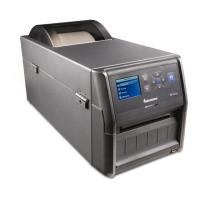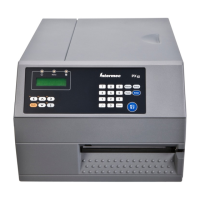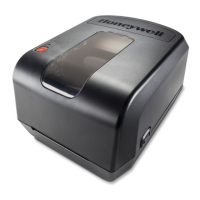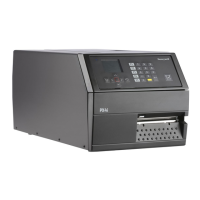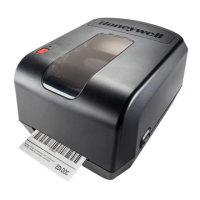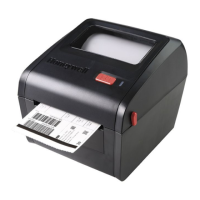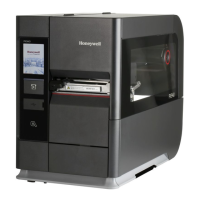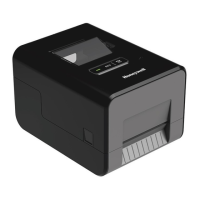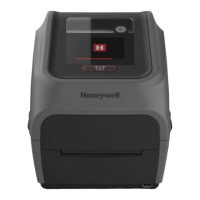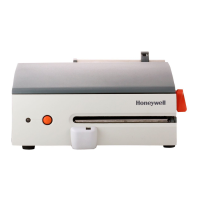What to do if my Honeywell PD45 says 'Front Arm Lifted'?
- TTammy Griffin PhDSep 23, 2025
If your Honeywell Printer indicates 'Front Arm Lifted', lower the Front Arm.
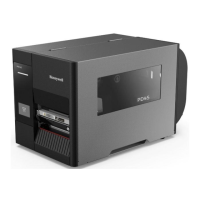
What to do if my Honeywell PD45 says 'Front Arm Lifted'?
If your Honeywell Printer indicates 'Front Arm Lifted', lower the Front Arm.
How to fix dark lines along the media path on my Honeywell PD45 Printer?
If there are dark lines along the media path on your Honeywell Printer's printouts, the printhead may be dirty. Clean the printhead.
What causes ribbon wrinkles on a Honeywell PD45 Printer and how to fix it?
If the ribbon wrinkles on your Honeywell Printer, try these possible solutions in order: * Reduce darkness setting, the darkness setting may be too high. * You may need to adjust the media edge guide and use/adjust the Media roll holder. * Adjust Printhead Pressure and Toggle Position due to incorrect or uneven printhead pressure. * Adjust the ribbon tension bar by turning the tension bar screw clockwise to move the bar lower and decrease the tension, or counterclockwise to move the bar upper and increase the tension.
Why is the printout darker or bleeding on my Honeywell PD45 Printer?
If the printout from your Honeywell Printer is dark or there is excessive bleeding on the media, try these possible solutions in order: * Make sure your media > print quality setting is appropriate for the type of media you are using. * Decrease the contrast, the contrast may be too high. * Decrease the printhead pressure, the printhead pressure may be too high.
What if part of a dotted line is missing on my Honeywell PD45 Printer's printout?
If part of a dotted line is missing on your Honeywell Printer's printout, try these possible solutions in order: The printhead may be failing, so replace the printhead.
What to do if my Honeywell Printer is connected to a serial port but not working?
If your Honeywell Printer is connected to a serial port on the PC but is not working, try these possible solutions: * Make sure the serial port settings are configured correctly. * Make sure the serial cable pinouts are correct and that the cable is not damaged. * If you have the Windows driver for an RS-232 printer installed on your PC, uninstall the driver.
Why is my Honeywell Printer's boot up time slower than before?
If your Honeywell Printer's boot-up time is slower than before, try these possible solutions: * Remove the USB device or use a new (blank) USB. * If part of the dotted line is missing, replace the printhead because the printhead may be failing.
What to do if my Honeywell PD45 Printer shows 'Ribbon Installed'?
If your Honeywell Printer displays a 'Ribbon Installed' message, the printer is configured as a direct thermal printer, but a thermal transfer ribbon is installed. Remove the ribbon or configure the printer for thermal transfer media.
What to do if my Honeywell Printer is rebooting?
If your Honeywell Printer is rebooting, it will restart. Wait until the printer is ready before attempting to communicate with it.
What does it mean if my Honeywell PD45 says 'Printhead Too Hot'?
If your Honeywell Printer displays a 'Printhead Too Hot' message, it means the printhead has overheated and needs to cool down. Wait for printing to resume automatically.
| Print Technology | Direct Thermal / Thermal Transfer |
|---|---|
| Ribbon Core | 1 inch (25.4 mm) |
| Print Resolution | 203 dpi |
| Max Print Width | 4.25 inches (108 mm) |
| Max Print Speed | 8 ips (203 mm/s) |
| Connectivity | USB 2.0, RS-232, Ethernet |
| Media Handling | Label gap, label black mark |
| Media Thickness | 0.0025 inch to 0.01 inch (0.0635 mm to 0.254 mm) |
| Ribbon Width | 1 inch to 4.33 inches (25.4 mm to 110 mm) |
| Ribbon Length | 984 feet (300 meters) |
| Operating Temperature | 5°C to 40°C (41°F to 104°F) |
| Power Requirements | 100-240 VAC, 50/60 Hz |
| Media Width | 25.4 mm (1 in) to 118 mm (4.65 in) |
Details about the PD45 printer series, including connectivity and supported command languages.
Describes the display types for different PD45 printer models, including LCD and LED+Key.
Explains how the printer automatically senses label to label and incoming data streams.
Describes Direct Protocol, an English-like syntax for creating labels, tickets, and tags.
Introduces Fingerprint, a BASIC-inspired language for designing label formats and applications.
Explains IPL as a host-based command language for designing, modifying, and downloading label formats.
Describes ZSim (Zebra Printer Language Simulator) for interpreting Zebra programs without host changes.
Explains DPL for interpreting Datamax data streams without host changes.
Details Smart Printing, allowing independent printer operation without a host computer.
Provides steps to access the printer's web page for configuration and management.
Outlines methods to change the printer command language via web page, main menu, or PrintSet 5.
Details how to configure the command language using the printer's web interface.
Explains how to set the command language using the printer's on-device main menu.
Guides through the initial power-on process and startup wizard.
Explains how to calibrate the printer's touch screen for accurate input.
Discusses the types of media the printer can use, including labels, tickets, and continuous stock.
Provides step-by-step instructions for loading media for tear-off printing.
Detailed instructions with warnings on loading media for tear-off printing.
Instructions for loading media when using the peel and rewind mechanism.
Steps for loading media when the printer is equipped with a cutter accessory.
Instructions for loading fanfold media into the printer.
Explains the benefits of thermal transfer printing and ribbon selection.
Detailed instructions for loading a thermal transfer ribbon into the printer.
Steps for safely removing used ribbon from the printer.
How to print a test label to verify print quality and printer function.
Guidance on adjusting printhead pressure and toggle position for optimal print quality.
Instructions on connecting the printer directly to a computer.
Details connecting the printer via an RS-232 serial cable for communication.
Steps for connecting the printer to a PC using a USB cable, including driver installation.
Explains how to connect the printer to a wired or wireless network for shared access.
Instructions for connecting the printer to a network using an Ethernet cable.
Information on connecting the printer wirelessly using an optional Wi-Fi module.
Steps to configure Wi-Fi settings through the printer's web interface.
How to set up Wi-Fi communications using the printer's main menu.
Guidance on installing security certificates for enhanced Wireless 802.11 security.
Explains the need for printer drivers and where to download them.
Detailed steps for installing the Honeywell Windows driver (InterDriver).
Describes the function of the USB host port for connecting peripherals.
Instructions on connecting USB storage devices and other peripherals to the printer.
Overview of the printer's configuration menu structure across different interfaces.
How to view and change configuration settings via the printer's main menu.
Methods to secure the printer's main menu using a PIN or disabling access.
Steps to access the printer's web page for configuration.
Default login credentials and how to change them for the printer web page.
Detailed guide to configuring printer settings through its web page.
Instructions on using the PrintSet 5 software for printer configuration.
How to change settings by sending commands via terminal programs or network connections.
Steps to upload files like fonts, images, and applications using the printer web page.
Guide for installing fonts, images, and applications from a USB storage device.
Instructions on customizing the printer's ready screen with a custom image.
Explains saving and loading printer settings as profiles for different configurations.
Steps to save the current printer settings as a profile using the main menu.
How to load a previously saved printer profile from the main menu.
Instructions for loading printer profiles via programming commands.
Guide to installing configuration files from a USB drive.
How to save printer configuration files to a USB drive.
Explains how to create shortcuts for frequently used menus or items.
Step-by-step guide to creating custom menu shortcuts.
How to view useful information and statistics about the printer's hardware and firmware.
Using the printer web page to view important operational statistics.
Checking printhead usage and comparing values against alert thresholds.
Configuring the printer to send alert messages for specific conditions or thresholds.
How to define thresholds for maintenance alerts to be sent.
A section dedicated to finding solutions for various printer problems.
Troubleshooting common issues related to print quality and output.
Solutions for ribbon wrinkling issues, including darkness and tension adjustments.
Troubleshooting steps for PC connection issues and printing stoppages.
Troubleshooting common issues with Ethernet or wireless network connections.
Instructions on how to restore the printer to its factory default settings.
Steps to restore defaults using the printer's web interface.
How to restore factory defaults using the printer's main menu.
Procedure for performing a hardware-based reset to restore printer defaults.
Information on checking for and updating the printer's firmware.
Steps to upgrade printer firmware using a USB storage device.
General instructions and precautions for cleaning the printer components.
Detailed steps and warnings for cleaning the printer's printhead.
How to clean the front sensor to ensure proper media detection.
Instructions for cleaning the media path, including guides and sensors.
Tips for cleaning the printer's outer casing to prevent dust ingress.
Comprehensive guide on how to replace the printer's printhead.
How to calibrate the printer's sensors for accurate media detection.
Adjusting the label gap and black mark sensors for optimal media tracking.
Where to find detailed printer and environmental specifications on the Honeywell website.
Lists supported command languages and simulator features.
Details the types of print sensors used in the printer.
Lists network services supported by the printer, such as FTP, SNMP, and Telnet.
Information about fonts supported by the printer, including resident and downloadable types.
Lists the fonts that are pre-installed on the printer.
Lists the types of fonts supported by the printer (TrueType, OpenType, Bitmap).
Lists the 1D and 2D barcode symbologies that the printer can generate.
Enumerates the various 1D barcode types supported by the printer.
Enumerates the various 2D barcode types supported by the printer.
Details default settings for serial and Ethernet communications.
Default settings for Ethernet network configuration, including IP addressing.
Default settings related to media handling, such as media type and print method.
Default settings for print speed, media sensitivity, darkness, contrast, and rotation.
Default settings for general system configuration, including name, location, and language.
Using the INPrint page to print single labels via web forms.
Details available accessories like Wi-Fi Module and Accessory Cutter.
